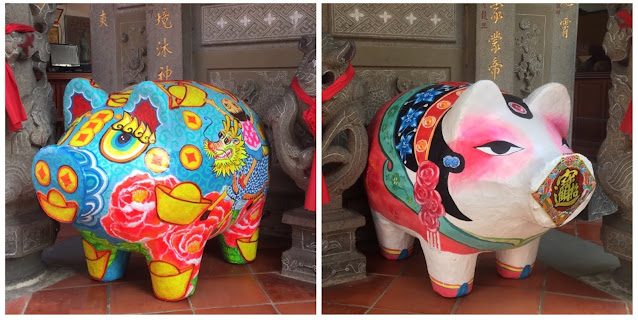Chinese New Year, also known as the Spring Festival, does not have a fixed date and is usually celebrated at the end of January or the beginning of February, according to the Lunar Calendar. In Taiwan, the country follows the Gregorian Calendar officially, but traditional holidays are still celebrated based on the Lunar Calendar.
The Chinese New Year starts on January 1 and lasts until the 15th, which is known as the Lantern Festival. Each year is associated with a zodiac animal. This year, according to the Minguo calendar used in Taiwan, is the Year of the Pig. The zodiac cycle repeats every 12 years, and each lunar cycle completes a 60-year cycle. It is believed to be unlucky to celebrate your zodiac year.
Traditionally, Lunar New Year was a time for praying to the gods for a good planting and harvesting season. People also pray to their ancestors, and many older people have a separate room dedicated to the gods, where they offer food and prayers. On Chinese New Year's Eve, firecrackers are set off to scare away monsters and bad luck. People also burn fake paper money and printed gold bars to honor their ancestors.
Sycee, also known as yuanbao, was a type of silver or gold currency used during the Qing Dynasty. They were not standardized by a central bank, so they came in various shapes and sizes. The most common shapes were square or oval, but there were also ones shaped like boats, flowers, or tortoises. Today, sycee is a symbol of wealth and prosperity and is commonly used during the Lunar New Year.
One important god during this time is the Door God. People often hang paintings of this god on their front doors. Door Gods typically have fierce and forceful appearances because they are meant to protect the family from demons. Some people also hang auspicious phrases or poetry on the left side, right side, and above the door. Another form of decoration is the word "fortune" pasted on doors or windows.
During this holiday, people exchange gifts, and children usually receive lucky money in red envelopes. Special foods are also prepared, such as tangyuan (sticky rice balls cooked in sweet soup), nian gao (sticky rice cake), and fa gao (a cake made of rice flour and steamed).
Traditionally, people clean their homes before the Chinese New Year and prepare food so that they don't have to do any work during the holidays. Sweeping and using knives or scissors is considered bad luck during this time, and cutting hair during the holiday period is believed to snip away good fortune. Houses are decorated with red, which symbolizes good luck, while white, associated with funerals, is avoided.
In Chinese culture, families gather to have dinner together on Lunar New Year's Eve, which is considered the most important meal of the year. After dinner, children receive red envelopes with money. The New Year usually begins with the sound of firecrackers, and on the second day, married daughters return to their parents' home with their husbands and children. In the past, there used to be various celebrations each day leading up to the Lantern Festival on the 15th day.
See also: Lantern Festival












0 komentarze:
Post a Comment